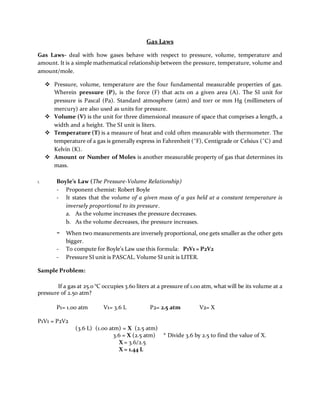
Gas laws (Boyle and Charles' Laws) handout
- 1. Gas Laws Gas Laws- deal with how gases behave with respect to pressure, volume, temperature and amount. It is a simple mathematical relationship between the pressure, temperature, volume and amount/mole. Pressure, volume, temperature are the four fundamental measurable properties of gas. Wherein pressure (P), is the force (F) that acts on a given area (A). The SI unit for pressure is Pascal (Pa). Standard atmosphere (atm) and torr or mm Hg (millimeters of mercury) are also used as units for pressure. Volume (V) is the unit for three dimensional measure of space that comprises a length, a width and a height. The SI unit is liters. Temperature (T) is a measure of heat and cold often measurable with thermometer. The temperature of a gas is generally express in Fahrenheit (˚F), Centigrade or Celsius (˚C) and Kelvin (K). Amount or Number of Moles is another measurable property of gas that determines its mass. I. Boyle’s Law (The Pressure-Volume Relationship) - Proponent chemist: Robert Boyle - It states that the volume of a given mass of a gas held at a constant temperature is inversely proportional to its pressure. a. As the volume increases the pressure decreases. b. As the volume decreases, the pressure increases. - When two measurements are inversely proportional, one gets smaller as the other gets bigger. - To compute for Boyle’s Law use this formula: P1V1 = P2V2 - Pressure SI unit is PASCAL. Volume SI unit is LITER. Sample Problem: If a gas at 25.0 °C occupies 3.60 liters at a pressure of 1.00 atm, what will be its volume at a pressure of 2.50 atm? P1= 1.00 atm V1= 3.6 L P2= 2.5 atm V2= X P1V1 = P2V2 (3.6 L) (1.00 atm) = X (2.5 atm) 3.6 = X (2.5 atm) * Divide 3.6 by 2.5 to find the value of X. X = 3.6/2.5 X = 1.44 L
- 2. Practice Problems 1. A science class puts a balloon containing 1.25 L of air at 101 kPa into a bell jar. Using an air pump, the class removes some of the air in the jar, causing the balloon to expand to a volume of 2.25 L. Assuming a constant temperature, what is the new pressure inside the jar? 2. A small balloon is inflated with helium at 102 kPa to a volume of 2.12 L. According to the balloon’s manu- facturer, if the balloon is stretched to a volume of 4.25 L, the balloon will pop. If the balloon were released, at what pressure would the balloon pop? Assume constant temperature through- out. Activity: Compute for the following. Show your computations and write your answers on a one whole sheet of paper. 1. A gas occupies 1.56 L at 1.00 atm. What will be the volume of this gas if the pressure becomes 3.00 atm? 2. A gas occupies 11.2 liters at 0.860 atm. What is the pressure if the volume becomes 15.0 L? 3. A gas occupies 4.31 liters at a pressure of 0.755 atm. Determine the volume if the pressure is increased to 1.25 atm. 4. .At a sewage treatment plant, methane is gathered for energy use. If 75 L of methane is produced at 94 kPa, how many liters would be produced at 100 kPa? Assume temperature remains constant throughout. 5. A sample of carbon dioxide occupies a volume of 3.50 liters at 125 kPa pressure. What pressure would the gas exert if the volume was decreased to 2.00 liters? 6. Helium occupies a volume of 15.0 liters at 432 Pa pressure. What would be the new volume if the final pressure is 400 Pa?
- 3. II. Charles’ Law - The Temperature-Volume Relationship. - Proponent: Jacques Charles - Charles' Law states: the volume of a fixed amount of gas maintained at constant pressure is directly proportional to its absolute temperature. a. As the temperature increases, the volume also increases. b. As the temperature decreases, the volume also decreases. - When two measurements are directly proportional, as one changes in size the other undergoes the same size change. - Charles' Law is expressed by the equation: - Temperatures used in all Gas Law calculations must be in Kelvin (K) units. Conversion: K = o C + 273 - Sample Problem: A fixed quantity of gas at 23 o C exhibits a pressure of 735 torr and occupies a volume of 5.22 liters. What volume will the gas occupy if the temperature is increased to 165 o C while the pressure is held constant? Practice Problems 1. What is the volume of the air in a balloon that occupies 0.620 L at 25C if the temperature is lowered to 0.00C? 2. The Celsius temperature of a 3.00-L sample of gas is lowered from 80.0C to 30.0C. What will be the resulting volume of this gas? 7.72 L
- 4. Activity Compute for the following items. Show your computations in the space provided. 1. A gas occupies 1.00 L at standard temperature. What is the volume at 333.0 °C? 2. The temperature of a 4.00 L sample of gas is changed from 10.0 °C to 20.0 °C. What will the volume of this gas be at the new temperature if the pressure is held constant? 3. When 50.0 liters of oxygen at 20.0 °C is compressed to 5.00 liters, what must the new temperature be to maintain constant pressure? 4. A gas syringe contains 56.05 liters of a gas at 315.1 K. Determine the volume that the gas will occupy if the temperature is increased to 380.5 K. 5. If pressure is known to be constant, what was the original volume of a sample of gas that was collected at 90 o C when its volume is 200 liters at 15 o C?
